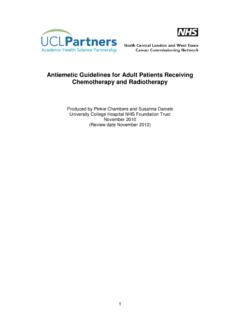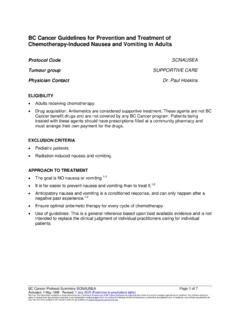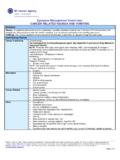Transcription of Pathophysiology and Management of Nausea and …
1 Pathophysiology and Management of Nausea and Vomiting Mechanisms of Nausea and Vomiting There is a differential diagnosis to Nausea which can be used to choose the most effective initial Management . Nausea and vomiting involves the stimulation of the VC in the medulla by one or more of the following pathways and is mediated by varying neurotransmitters: Peripheral Pathways o Nausea triggered by mechanoreceptors and chemoreceptors in the GI tract, serosa, and viscera; transmitted via the vagus and splanchnic nerves, sympathetic ganglia, and glossopharyngeal nerves to the Chemoreceptor Trigger Zone (CTZ) and VC. Vestibular System o Nausea triggered by motion; transmitted via the vestibulocochlear nerve to the VC.
2 Chemoreceptor Trigger Zone (CTZ) o Nausea triggered by toxins in both the blood stream and CSF. Cortex o Nausea triggered by sensory input, anxiety, meningeal irritation, and increased intracranial pressure. The Vomiting Center (VC) is the final common pathway for vomiting. This center initiates coordinated responses from the parasympathetic system and motor efferents to produce vomiting. The Rational Approach to Nausea and Vomiting: 1. Identify all of the potential underlying causes/triggers 2. If possible, eliminate causes/triggers (medications, constipation, etc) 3. Identify the pathway and associated neurotransmitters (see Table 1 and Figure 1) 4.
3 Choose the medications that best target the neurotransmitters involved (See Table 1 and Table 2) 5. Schedule medication ATC and titrate to effect 6. If symptoms are refractory despite adequate dosing, combine several therapies to block multiple pathways. BenzodiazepinesCorticosteroidsAnticholin ergics, AntihistaminesPhenothiazines, Butyrophenones, 5HT3 antagonists Pharmacologic intervention PPIs, Phenothiazines Corticosteroids, Prokinetics Table 1: Differential Diagnosis of Nausea and Vomiting Differential Diagnosis Examples of Clinical Scenarios Notable History/ Physical Exam Most Common Neural Pathway Involved Receptors to Block Targeted Pharmacotherapy Central Nervous System Origin Vestibular Motion sickness; Acoustic neuroma; Nystagmus.
4 Vertigo Nausea worse with movement, Dizziness Vestibular Nucleus AChM, H1 Anticholinergics, antihistamines Toxins chemotherapy Recent emetogenic chemotherapy Stimulation of CTZ (via 5HT3 & NK1) Serotonin released in gut, stimulating peripheral pathways Anxiety 5HT3, NK-1, D2 See Chemo Guideline (hyperlink this) Medications (antibiotics, opioids, digoxin, SSRIs, TCAs) Recent medication changes (additions or deletions) Direct effect on the CTZ via D2 (central) D2 If possible, stop offending medication;Prokinetics; Butyrophenones; Phenothiazines Metabolic abnormalities (uremia, liver failure, infection, ketoacidosis, electrolyte abnormalities [hyper/hypocalcemia, hyper/hyponatremia, hypokalemia]) Altered mental status Direct effect on the CTZ via D2 (central) D2 Treat underlying abnormalities; Butyrophenones; Phenothiazines; Prokinetics Intracranial Brainstem or cerebellar lesions.
5 Increased intracranial pressure via inflammation/edema symptoms, headache, neck stiffness, papilledema, neurologic signs Cortex H1 and AChM Corticosteroids; Antihistamines; Butyrophenones; Phenothiazines Anxiety Anticipatory Nausea and vomiting; Nausea as a manifestation of anxiety Nausea without vomiting or weight loss; History of severe Nausea post chemotherapy , mood/anxiety disorder, significant history of Nausea in youth. Cortex Treat underlying anxiety (benzodiazepines prn); Consider SSRIs for patients with chronic anxiety (may contribute to medication induced Nausea ) Gastrointestinal Origin Mechanical Stretch Constipation, Malignant Bowel Obstruction, Peritoneal carcinomatosis, Biliary obstruction, Hepatic capsular distension Large/infrequent vomitus that relieves Nausea ; Crampy abdominal pain; Decreased frequency of BMs, abdominal fullness and distension, hard stools, straining with defecation, abnormal BS, fecal impaction.
6 Peripheral pathways: stimulation of mechanoreceptors D2, AchM/H1 Treat underlying constipation; Corticosteroids (for obstruction and hepatic capsular distension); Butyrophenones; Phenothiazines; Anticholinergics (for cramping) Gastroparesis Small-volume emesis, early satiety, bloating, Nausea with movement; h/o neuropathy, hypothyroidism, or diabetes mellitus; peritoneal carcinomatosis Peripheral pathways: Mechanoreceptors D2 Prokinetics GI Mucosal Irritation induced by GERD, PUD, Radiation, Infection, Inflammation, chemotherapy , Medications Esophageal burning, sour taste in mouth, worse when supine.
7 Epigastric pain radiating to back, fever, diarrhea Peripheral Pathways: Chemoreceptors via Serotonin released in gut AChM, H1, D2, 5HT3 H2 blockers or PPI (GERD/ PUD) 5HT3 antagonists (Chemo) Corticosteroids (Inflammation) Anticholinergics (for cramping) Treat underlying infection Glossopharyngeal Irritation Oropharyngeal cancer, Thick adherent mucus, Inflammation (gingivitis, dental caries), Infection (oropharyngeal candidiasis, HSV), Radiation Thrush, herpetic lesions; mucositis, gingivitis; h/o radiation; dysphagia, odynophagia Peripheral pathways via stimulation of mechano and chemoreceptors of the glossopharyngeal nerve Mouthcare (chlorhexidine mouthwash), Treat the underlying infection Table 2.
8 Antiemetics Antiemetic Trade Name Neural Pathway Targeted Receptor Affinities Dosage Major Adverse Effects D2 H1 AchM 5HT3 Prokinetics Metoclopramide Reglan Peripheral (Decreased mechanoreceptor stimulation) CTZ ++ ++ (agonist) + (at high doses) 5-20 mg PO/SC/IV before meals and at bedtime Akathisia, EPS, colic in GI obstruction (Risk of perforation in patients with complete GI obstruction) Butyrophenones Haloperidol Haldol CTZ +++ mg PO/SC/IV/PR q8h and q4h prn Akathisia, EPS, QT prolongation with high doses Phenothiazines Prochlorperazine Compazine CTZ Vestibular ++ + 5-10 mg PO/IV q6h or 25 mg PR q6h Akathisia, EPS, sedation (less than promethazine)
9 Promethazine Phenergan CTZ Vestibular + + ++ mg PO/IV q6h or 25 mg PR q6h Akathisia, EPS (less than haloperidol and prochlorperazine), sedation Anticholinergics Scopolamine Transderm Scop Vestibular ++ mg transdermal patch every 3 days Sedation, dry mouth, urinary retention, constipation, delirium Hyoscyamine Levsin Vestibular ++ mg SL/PO q4h Sedation, dry mouth, urinary retention, constipation.
10 Delirium Glycopyrrolate Robinul Vestibular ++ IV/SC: mg q6h PO: 1-2 mg q6h Sedation, dry mouth, urinary retention, constipation Antihistamines Meclizine Antivert Vestibular ++ 25-100 mg/day in divided doses TID Sedation, dry mouth, urinary retention Diphenhydramine Benadryl Vestibular ++ + 25-50 mg PO/IV/SC q6h Sedation, dry mouth, urinary retention, delirium 5HT3 antagonists Ondansetron1 Zofran CTZ Peripheral pathways ++ 4-8 mg PO/IV q4-8h Headache.









